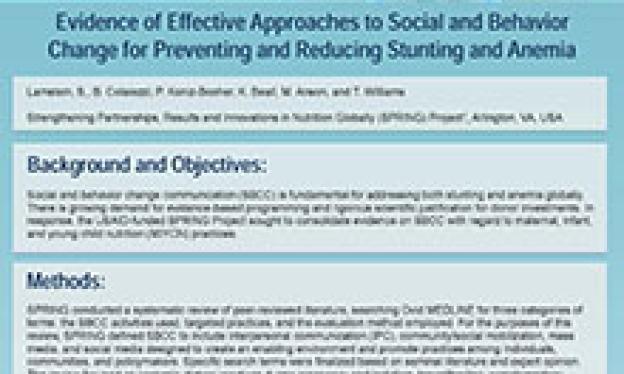Authors: Lamstein S; Colaiezzi B; Koniz-Booher P; Beall K; Anson M; Williams T
Background and objectives: Social and behavior change communication (SBCC) is fundamental for addressing both stunting and anemia globally. There is growing demand for evidence-based programming and rigorous scientific justification for donor investments. In response, the USAID-funded SPRING Project sought to consolidate evidence on SBCC with regard to maternal, infant, and young child nutrition (MIYCN) practices.
Methods: SPRING conducted a systematic review of peer-reviewed literature, searching Ovid MEDLINE for three categories of terms: the SBCC activities used, targeted practices, and the evaluation method employed. For the purposes of this review, SPRING defined SBCC to include interpersonal communication (IPC), community/social mobilization, mass media, and social media designed to create an enabling environment and promote practices among individuals, communities, and policymakers. Specific search terms were finalized based on seminal literature and expert opinion. The review focused on women’s dietary practices during pregnancy and lactation; breastfeeding; complementary feeding; prevention and control of micronutrient deficiencies; and water, sanitation, and hygiene (WASH) practices in the context of nutrition. SPRING reviewed articles that met the following inclusion criteria: published in or after the year 2000, based on research in developing countries, and the provision of evidence of effectiveness of SBCC in promoting a priority MIYCN practice.
Results: A total of 117 peer-reviewed journal articles met the researchers’ inclusion criteria: 9 related to women’s dietary practices, 51 on breastfeeding, 30 on complementary feeding, 33 on the control and prevention of micronutrient deficiencies, and 9 on WASH. The review includes detailed analysis and graphs regarding each topical area. As depicted in the figure, a wide range of interventions have been used to address or promote these practices with the majority of articles describing interventions that used multiple approaches. Interpersonal communication approaches were by far the most commonly employed. Over half of the interventions targeted only one audience, typically the pregnant/lactating woman or the child’s primary caregiver. A variety of approaches to SBCC have been found to be effective (either single or combination interventions) depending on the context and other factors such as timing, frequency, intensity, duration, and quality. However, interventions involving home visits and peer counseling consistently reported some of the greatest positive changes in MIYCN practices.
Conclusions: The findings of this review suggest the importance of promoting both broader social change and individual behavior change at all possible contact points. The predominance of IPC was striking. Results underscore the importance of context and the enabling environment as well as the role of delivery science including management, supervision, and training processes.
This review also highlights a number of critical areas in need of further research and reflection, such as the relative effectiveness, complementarity and cost of SBCC implemented at scale. The findings are intended to guide future program planning and implementation and help prioritize the most promising approaches to SBCC.
